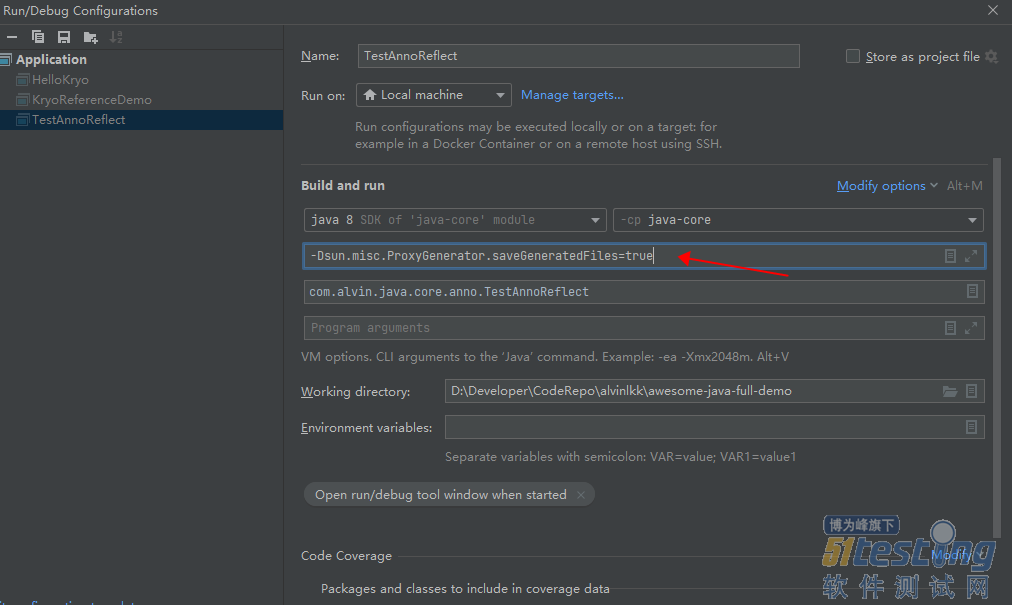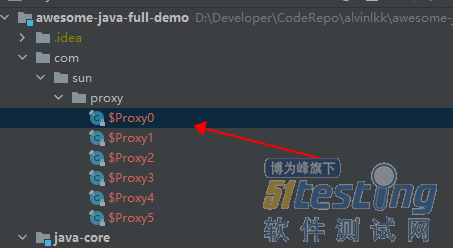看到最后,你才发现Java中注解原来是这么做到的!
概述
注解想必大家在项目中经常使用,比如Spring框架中常用的一些注解:@Controller、@Service、@RequestMapping等等,它是JDK1.5及以后版本引入的一个特性。它可以声明在包、类、字段、方法、局部变量、方法参数等的前面,用来对这些元素进行说明,注释。那么你知道JDK什么是元注解吗?注解有哪些分类吗?以及注解在Java中最本质究竟是什么东西,是如何实现的呢?
注解的分类
根据注解的使用场景,主要分为三类,元注解、内置注解和自定义注解。
元注解
用于定义注解的注解,通常用于注解的定义上,标明该注解的使用范围、生效范围等。简而言之,元注解是用来修饰注解的。
@Retention
指定注解信息保留到哪个阶段,分别为源代码阶段、编译Class阶段、运行阶段。
@Documented
@Retention(RetentionPolicy.RUNTIME)
@Target(ElementType.ANNOTATION_TYPE)
public @interface Retention {
/**
* Returns the retention policy.
* @return the retention policy
*/
RetentionPolicy value();
}
SOURCE: 保留在源代码java中,被编译器丢弃,也就是说在class文件中不包含注解信息,通常用来标记源码,引起大家的注意,比如自定义一个注解例如@ThreadSafe,用来标识一个类时线程安全的。
CLASS: 编译后的class文件中包含注解信息,但是会被jvm丢弃
RUNTIME: 注解信息在运行期(JVM)保留(.class也有),可以通过反射机制读取注解的信息
@Target
指定注解的使用范围,如类、方法、属性、局部属性、参数等, 可以多选。
@Documented
@Retention(RetentionPolicy.RUNTIME)
@Target(ElementType.ANNOTATION_TYPE)
public @interface Target {
/**
* Returns an array of the kinds of elements an annotation type
* can be applied to.
* @return an array of the kinds of elements an annotation type
* can be applied to
*/
ElementType[] value();
}
具体可选的枚举如下:
public enum ElementType {
/** 适用范围:类、接口、注解类型,枚举类型enum */
TYPE,
/** 作用于类属性 (includes enum constants) */
FIELD,
/** 作用于方法 */
METHOD,
/** 作用于参数声明 */
PARAMETER,
/** 作用于构造函数声明 */
CONSTRUCTOR,
/** 作用于局部变量声明 */
LOCAL_VARIABLE,
/** 作用于注解声明 */
ANNOTATION_TYPE,
/** 作用于包声明 */
PACKAGE,
/** 作用于类型参数(泛型参数)声明 */
TYPE_PARAMETER,
/** 作用于使用类型的任意语句(不包括class) */
TYPE_USE
}
@Inherited
加上该注解的注解,表示可以被标注的类子类继承,比如A上标记了带有@Inherited的注解,那么类B继承了A, 那么B也会有这个注解,默认情况**解是不支持继承的。
@Documented
@Retention(RetentionPolicy.RUNTIME)
@Target(ElementType.ANNOTATION_TYPE)
public @interface Inherited {
}
@Document
将此注解包含在 javadoc 中 ,它代表着此注解会被javadoc工具提取成文档。
@Documented
@Retention(RetentionPolicy.RUNTIME)
@Target(ElementType.ANNOTATION_TYPE)
public @interface Documented {
}
@Repeatable
1.8中加入的元注解,用来标记是否可以重复标记。
@Documented
@Retention(RetentionPolicy.RUNTIME)
@Target(ElementType.ANNOTATION_TYPE)
public @interface Repeatable {
/**
* Indicates the <em>containing annotation type</em> for the
* repeatable annotation type.
* @return the containing annotation type
*/
Class<? extends Annotation> value();
}
内置注解
java提供了一些内置注解,可以配合编译器来检查代码的正确性, 我们可以关注他们的元注解。
@Override
标记当前方法是覆写父类的方法。
@Target(ElementType.METHOD)
@Retention(RetentionPolicy.SOURCE)
public @interface Override {
}
@Deprecated
标记一个元素为已过期,不要在使用了
@Documented
@Retention(RetentionPolicy.RUNTIME)
@Target(value={CONSTRUCTOR, FIELD, LOCAL_VARIABLE, METHOD, PACKAGE, PARAMETER, TYPE})
public @interface Deprecated {
}
@SuppressWarnings
用来关闭编译器输出的警告信息
@Target({TYPE, FIELD, METHOD, PARAMETER, CONSTRUCTOR, LOCAL_VARIABLE})
@Retention(RetentionPolicy.SOURCE)
public @interface SuppressWarnings {
String[] value();
}
@FunctionalInterface
java8中引入,标记是一个函数式接口,也就是说有且只有一个抽象方法的接口
@Documented
@Retention(RetentionPolicy.RUNTIME)
@Target(ElementType.TYPE)
public @interface FunctionalInterface {}
自定义注解
注解遵循的格式一般如下:
//元注解部分 xxxx
@Retention(xxxx)
@Target(xxxx)
public @interface 注解名 {
返回值 属性名() 默认值;
返回值 属性名() 默认值;
}
返回值支持的类型如下:java的8种基础类型(不支持包装类型)、String、Class、Enum、Annotation、以及上面类型的数组。
默认值可选,非必有。
举个项目中自定义的栗子:
@Target({ElementType.METHOD})
@Retention(RetentionPolicy.RUNTIME)
@Documented
@Inherited
public @interface DataAuthorize {
/**
* 资产ID
* @return
*/
String assetId();
/**
* 资产类型
* @return
*/
String assetType();
/**
* 权限代码
* @return
*/
String authCode() default "";
/**
* 使用的类型
* @return
*/
Class[] useType();
}
使用反射操作注解
大部分情况下,我们的项目或者开源框架中都定义了大量的注解,而且都是@Retention(RetentionPolicy.RUNTIME)运行时阶段,我们可以通过反射获取注解中的信息,所以整体遵循下面的一个范式。
1. 自定义注解
2. 扫描注解
3. 通过反射获取注解的信息,执行相应的逻辑。
下面我们重点使用下如何用反射来获取注解的信息。
1. 定义target是注解的注解
@Inherited
@Retention( value = RetentionPolicy.RUNTIME)
@Target(value = {ElementType.ANNOTATION_TYPE})
public @interface AnnoTest {
String value() default "anno";
}
2. 定义一个几乎全量信息的注解
@AnnoTest("alvinAnno")
@Inherited
@Retention( value = RetentionPolicy.RUNTIME)
@Target(value = {ElementType.TYPE_USE,ElementType.PACKAGE,ElementType.FIELD,
ElementType.TYPE_PARAMETER,ElementType.CONSTRUCTOR,ElementType.LOCAL_VARIABLE})
@Documented
public @interface FullAnnoTest {
String value() default "FullAnnoTest";
}
3. 定义测试类和反射代码
@FullAnnoTest("package")
package com.alvin.java.core.anno;
public class ParentObj {
}
@FullAnnoTest("testAnnoReflect")
public class TestAnnoReflect<@FullAnnoTest("parameter") T > extends @FullAnnoTest("parent")ParentObj {
@FullAnnoTest("constructor")
TestAnnoReflect() {
}
//注解字段域
private @FullAnnoTest("name") String name;
//注解泛型字段域
private @FullAnnoTest("value") T value;
//注解通配符
private @FullAnnoTest("list") List<@FullAnnoTest("generic") ?> list;
//注解方法
@FullAnnoTest("method") //注解方法参数
public String hello(@FullAnnoTest("methodParameter") String name)
throws @FullAnnoTest("Exception") Exception { // 注解抛出异常
//注解局部变量,现在运行时暂时无法获取(忽略)
@FullAnnoTest("result") String result;
result = "siting";
System.out.println(name);
return result;
}
public static void main(String[] args) throws Exception {
TestAnnoReflect<String> TestAnnoReflect = new TestAnnoReflect<> ();
Class<TestAnnoReflect<Object>> clazz = (Class<TestAnnoReflect<Object>>) TestAnnoReflect.getClass();
//class的注解
Annotation[] annotations = clazz.getAnnotations();
FullAnnoTest testTmp = (FullAnnoTest) annotations[0];
System.out.println("修饰TestAnnoReflect.class注解value: "+testTmp.value());
//构造器的注解
Constructor<TestAnnoReflect<Object>> constructor = (Constructor<TestAnnoReflect<Object>>) clazz.getDeclaredConstructors()[0];
testTmp = constructor.getAnnotation(FullAnnoTest.class);
System.out.println("修饰构造器的注解value: "+testTmp.value());
//继承父类的注解
AnnotatedType annotatedType = clazz.getAnnotatedSuperclass();
testTmp = annotatedType.getAnnotation(FullAnnoTest.class);
System.out.println("修饰继承父类的注解value: "+testTmp.value());
//注解的注解
AnnoTest AnnoTest = testTmp.annotationType().getAnnotation(AnnoTest.class);
System.out.println("修饰注解的注解AnnoTest-value: "+AnnoTest.value());
//泛型参数 T 的注解
TypeVariable<Class<TestAnnoReflect<Object>>> variable = clazz.getTypeParameters()[0];
testTmp = variable.getAnnotation(FullAnnoTest.class);
System.out.println("修饰泛型参数T注解value: "+testTmp.value());
//普通字段域 的注解
Field[] fields = clazz.getDeclaredFields();
Field nameField = fields[0];
testTmp = nameField.getAnnotation(FullAnnoTest.class);
System.out.println("修饰普通字段域name注解value: "+testTmp.value());
//泛型字段域 的注解
Field valueField = fields[1];
testTmp = valueField.getAnnotation(FullAnnoTest.class);
System.out.println("修饰泛型字段T注解value: "+testTmp.value());
//通配符字段域 的注解
Field listField = fields[2];
AnnotatedParameterizedType annotatedPType = (AnnotatedParameterizedType)listField.getAnnotatedType();
testTmp = annotatedPType.getAnnotation(FullAnnoTest.class);
System.out.println("修饰泛型注解value: "+testTmp.value());
//通配符注解 的注解
AnnotatedType[] annotatedTypes = annotatedPType.getAnnotatedActualTypeArguments();
AnnotatedWildcardType annotatedWildcardType = (AnnotatedWildcardType) annotatedTypes[0];
testTmp = annotatedWildcardType.getAnnotation(FullAnnoTest.class);
System.out.println("修饰通配符注解value: "+testTmp.value());
//方法的注解
Method method = clazz.getDeclaredMethod("hello", String.class);
annotatedType = method.getAnnotatedReturnType();
testTmp = annotatedType.getAnnotation(FullAnnoTest.class);
System.out.println("修饰方法的注解value: "+testTmp.value());
//异常的注解
annotatedTypes = method.getAnnotatedExceptionTypes();
testTmp = annotatedTypes[0].getAnnotation(FullAnnoTest.class);
System.out.println("修饰方法抛出错误的注解value: "+testTmp.value());
//方法参数的注解
annotatedTypes = method.getAnnotatedParameterTypes();
testTmp = annotatedTypes[0].getAnnotation(FullAnnoTest.class);
System.out.println("修饰方法参数注解value: "+testTmp.value());
//包的注解
Package p = Package.getPackage("com.alvin.java.core.anno");
testTmp = p.getAnnotation(FullAnnoTest.class);
System.out.println("修饰package注解value: "+testTmp.value());
TestAnnoReflect.hello("hello");
}
}
4. 查看对应的执行结果
修饰TestAnnoReflect.class注解value: testAnnoReflect
修饰构造器的注解value: constructor
修饰继承父类的注解value: parent
修饰注解的注解AnnoTest-value: alvinAnno
修饰泛型参数T注解value: parameter
修饰普通字段域name注解value: name
修饰泛型字段T注解value: value
修饰泛型注解value: list
修饰通配符注解value: generic
修饰方法的注解value: method
修饰方法抛出错误的注解value: Exception
修饰方法参数注解value: methodParameter
修饰package注解value: package
hello
注解的本质和底层实现
大家有没有想过注解的本质是什么?
我们先通过反编译查看注解生成的字节码,可以通过javap -v FullAnnoTest.class查看如下:
可以看到,我们的注解是继承自Annotation接口。
public interface Annotation {
boolean equals(Object obj);
int hashCode();
String toString();
/**
* Returns the annotation type of this annotation.
* @return the annotation type of this annotation
*/
Class<? extends Annotation> annotationType();
}
所以注解相当于一个语法糖一样,可以方便我们使用,本质上它是继承自Annotation的一个接口。
那大家有没有想过它的实现类在哪里?比如下面的代码,获取到注解,按照上面的解释,它是一个接口,那调用value()方法时,它具体调用的哪个实现类呢?我们并没有写实现类啊.....
答案当然就是动态代理生成的实现类。
AnnoTest annoTest = testTmp.annotationType().getAnnotation(AnnoTest.class);
System.out.println("修饰注解的注解AnnoTest-value: "+annoTest.value());
我们可以在启动参数添加如下命令可以查看生成的代理类:-Dsun.misc.ProxyGenerator.saveGeneratedFiles=true
执行后,生成代理类如下,
代理大致的代码如下:
public final class $Proxy2 extends Proxy implements FullAnnoTest {
private static Method m1;
private static Method m2;
private static Method m4;
private static Method m0;
private static Method m3;
public $Proxy2(InvocationHandler var1) throws {
super(var1);
}
public final boolean equals(Object var1) throws {
try {
return (Boolean)super.h.invoke(this, m1, new Object[]{var1});
} catch (RuntimeException | Error var3) {
throw var3;
} catch (Throwable var4) {
throw new UndeclaredThrowableException(var4);
}
}
public final Class annotationType() throws {
try {
return (Class)super.h.invoke(this, m4, (Object[])null);
} catch (RuntimeException | Error var2) {
throw var2;
} catch (Throwable var3) {
throw new UndeclaredThrowableException(var3);
}
}
public final String value() throws {
try {
return (String)super.h.invoke(this, m3, (Object[])null);
} catch (RuntimeException | Error var2) {
throw var2;
} catch (Throwable var3) {
throw new UndeclaredThrowableException(var3);
}
}
static {
try {
m1 = Class.forName("java.lang.Object").getMethod("equals", Class.forName("java.lang.Object"));
m2 = Class.forName("java.lang.Object").getMethod("toString");
m4 = Class.forName("com.alvin.java.core.anno.FullAnnoTest").getMethod("annotationType");
m0 = Class.forName("java.lang.Object").getMethod("hashCode");
m3 = Class.forName("com.alvin.java.core.anno.FullAnnoTest").getMethod("value");
} catch (NoSuchMethodException var2) {
throw new NoSuchMethodError(var2.getMessage());
} catch (ClassNotFoundException var3) {
throw new NoClassDefFoundError(var3.getMessage());
}
}
}
我们看value()?方法,这里调用了super.h对象,也就是InvocationHandler?对象,而我们注解用的是AnnotationInvocationHandler这个子类,我们在invoke方法中打个断点,就明白了~~
相关阅读:
- Java面试被问到Dubbo,怎么回答可以得高分?(上) (liqianqian1116, 2023-4-10)
- Java面试被问到Dubbo,怎么回答可以得高分?(下) (liqianqian1116, 2023-4-10)
- 使用 Python 构建 GUI 最简单的方法 (liqianqian1116, 2023-4-12)
- Python文件和异常处理打开、读写和关闭文件详解 (liqianqian1116, 2023-4-11)
- 闲谈Java9到Java20,你学会了吗? (liqianqian1116, 2023-4-11)
- 用Python监控并分析城市空气质量 (liqianqian1116, 2023-4-17)
标题搜索
我的存档
数据统计
- 访问量: 252909
- 日志数: 959
- 建立时间: 2020-08-11
- 更新时间: 2024-04-26




